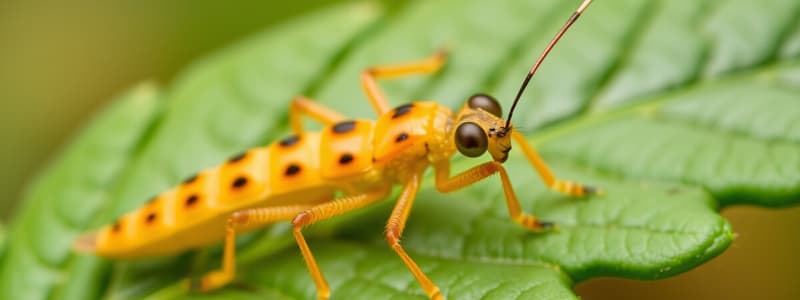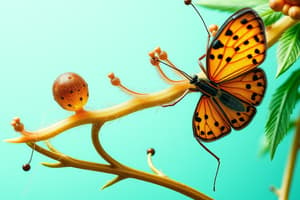Podcast
Questions and Answers
What characteristics do all living things share?
What characteristics do all living things share?
Living things are made up of basic units called cells, are based on a universal genetic code, obtain and use materials and energy, grow and develop, reproduce, respond to their environment, maintain a stable internal environment, and change over time.
Biology is the study of life. But what is life?
Biology is the study of life. But what is life?
No single characteristic is enough to describe a living thing. Some nonliving things share one or more traits with organisms. Some things, such as viruses, exist at the border between organisms and nonliving things.
All organisms store the complex information they need to live, grow, and reproduce in a __________ ________ written in a molecule called DNA.
All organisms store the complex information they need to live, grow, and reproduce in a __________ ________ written in a molecule called DNA.
universal genetic code
How do living things grow and develop?
How do living things grow and develop?
What is a stimulus in biological terms?
What is a stimulus in biological terms?
What does reproduction in living things involve?
What does reproduction in living things involve?
What is asexual reproduction?
What is asexual reproduction?
What is homeostasis?
What is homeostasis?
How do living things obtain and use material and energy?
How do living things obtain and use material and energy?
What is metabolism?
What is metabolism?
What links all forms of life to a common origin?
What links all forms of life to a common origin?
The study of ____________ revolves around several interlocking big ideas.
The study of ____________ revolves around several interlocking big ideas.
What are unicellular organisms?
What are unicellular organisms?
Life requires __________ that serves as nutrients to build body structures.
Life requires __________ that serves as nutrients to build body structures.
What is the significance of energy in life?
What is the significance of energy in life?
Flashcards are hidden until you start studying
Study Notes
Characteristics of Living Things
- Living organisms are composed of cells, the basic units of life.
- They rely on a universal genetic code stored in DNA, which is nearly identical across all species.
- Growth and development occur from a single fertilized egg that divides and differentiates into various cell types.
- All living things respond to environmental stimuli, such as plants producing chemicals to deter herbivores.
- Reproduction occurs either sexually, through the combination of two parent cells, or asexually, where one organism creates identical offspring.
Homeostasis and Metabolism
- Homeostasis is the ability to maintain a stable internal environment, crucial for survival amidst changing external conditions.
- Organisms metabolize by undergoing chemical reactions that build up or break down materials, essential for growth and energy.
Evolutionary Context
- Over generations, organisms evolve, establishing connections linking them to a common ancestor from over 3.5 billion years ago.
- Evolution provides insights into the physical traits and genetic structures of both living and extinct species.
Central Themes in Biology
- Biology encompasses several fundamental concepts, including:
- Cellular basis of life
- Information and heredity
- Matter and energy interactions
- Growth, development, and reproduction processes
- Homeostasis
- Evolution
- Structure-function relationships
- Unity and diversity of life
- Interdependence in ecosystems
- Scientific inquiry as a method of knowledge acquisition
Cellular Composition
- Living organisms can be unicellular (single-celled) or multicellular with diverse cell types performing specialized functions.
- The complexity of cells allows for growth, responsiveness, and reproduction.
Nutritional Requirements
- Living things require matter for nutrients and energy, vital for building structures and powering biological functions.
- Plants harness energy from sunlight, while animals obtain nutrients by consuming plants or other animals, creating a web of interdependence.
Studying That Suits You
Use AI to generate personalized quizzes and flashcards to suit your learning preferences.




